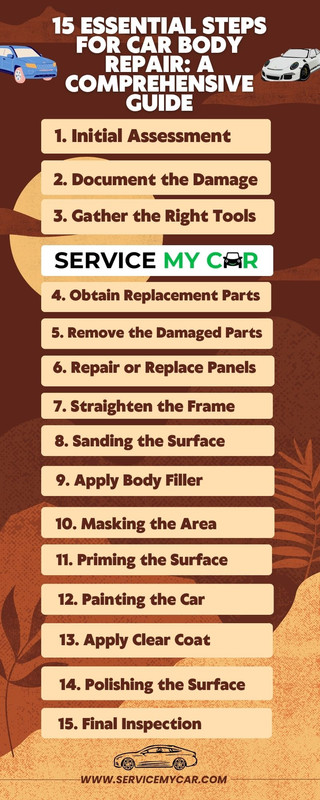|
Robert Klos

United Arab Emirates
21 Posts |
 Posted - Oct 03 2024 : 23:42:15 Posted - Oct 03 2024 : 23:42:15


|

Car body repair is essential for maintaining the appearance and structural integrity of your vehicle. Whether itís a minor scratch or significant collision damage, understanding the basic steps of car body repair can help you handle the process efficiently. Here are the 15 essential steps to guide you through this critical maintenance procedure.
1. Initial Assessment
The first step in car body repair is assessing the damage. Walk around your car and check for dents, scratches, or more serious issues such as crumpled panels. This assessment will help you understand the extent of the damage and determine the repair approach.
2. Document the Damage
Before beginning any repairs, take pictures of the damaged areas. This is particularly important if you are filing an insurance claim or want to track your progress through the repair process.
3. Gather the Right Tools
Youíll need specific tools for car body repairs such as sanders, body hammers, dollies, and putty knives. Make sure you have the right tools to perform the job efficiently.
4. Obtain Replacement Parts
If certain parts like bumpers, mirrors, or body panels are too damaged to be repaired, youíll need to purchase replacements. Itís crucial to find parts that match your carís model and year.
5. Remove the Damaged Parts
Start by removing any damaged components. This may include bumpers, fenders, or panels that canít be repaired. Be careful when removing parts to avoid further damage to surrounding areas.
6. Repair or Replace Panels
If the damage is minor, you can use a body filler to repair dents and scratches. For more significant damage, replacement of entire panels may be necessary. Weld or bolt the new parts in place, ensuring they align correctly.
7. Straighten the Frame
For vehicles with major damage, itís essential to check the carís frame. A bent frame can affect the performance and safety of your vehicle. Use a frame straightening machine to restore the frame to its original specifications.
8. Sanding the Surface
After any repairs are made, sanding the surface is crucial to ensure itís smooth and ready for painting. Use fine-grit sandpaper for light damage or a power sander for larger areas.
9. Apply Body Filler
For small dents and scratches, applying body filler will restore the smoothness of the carís surface. Use a putty knife to apply the filler, then sand it down to create an even surface.
10. Masking the Area
Before painting, cover all areas that wonít be painted using masking tape and paper. This ensures that the paint stays within the intended area and doesnít accidentally get on windows, lights, or trim.
11. Priming the Surface
Applying a primer helps paint adhere better to the carís surface and prevents rust from forming. Make sure the primer layer is even and smooth before moving on to the paint.
12. Painting the Car
Select the right color paint, preferably one that matches the manufacturerís code for your vehicle. Apply several coats of paint evenly, allowing each layer to dry before adding the next.
13. Apply Clear Coat
After the final layer of paint, a clear coat is applied to give the surface a glossy finish and protect the paint from damage. The clear coat should be applied evenly and left to cure thoroughly.
14. Polishing the Surface
Once the clear coat has dried, polishing the surface will bring out the carís shine. Use a buffer and a high-quality polish to give the car a smooth, glossy finish that looks professional.
15. Final Inspection
Lastly, inspect your work. Ensure all repairs are correctly completed, the paint matches the rest of the car, and no scratches or imperfections are visible. If necessary, perform touch-ups or polish again for the perfect finish.
Conclusion
Car body repair can seem like a daunting task, but by following these essential steps, you can achieve a professional finish and restore your vehicle to its original condition. Whether you're fixing minor dents or dealing with significant damage, understanding the process ensures your car stays in top shape both aesthetically and structurally.
Thanks for reading the blog. If you own a Nissan 350z and are looking for nissan 350z battery replacement in Dubai, Service My Car is your trusted partner. Get in touch with Service My Car to schedule your car battery change service.
klosrobert |
|

